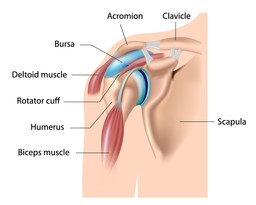

What is the Shoulder?
The shoulder is made of three bones, including the upper arm bone (humerus), shoulder blade (scapula) and collarbone (clavicle). Your shoulder is a ball and socket joint.

The head of the upper arm bone fits into a rounded socket in the shoulder blade, called the glenoid. The shoulder capsule and strong connective tissue keep the upper arm bone centered in the glenoid socket. The tissue covers the shoulder joint and attaches the upper arm bone to the shoulder blade. The shoulder relies on muscles and tendons to keep the shoulder stable.
What is Chronic Shoulder Instability?
This condition occurs when the head of the upper arm bone is forced out of the shoulder socket. Shoulder instability can be the result of sudden injury or from overuse.
Common Causes
There are several ways that a shoulder can experience shoulder instability, including shoulder dislocation, repetitive strain and multidirectional instability. A shoulder dislocation is often caused by severe injury or trauma. Patients also may have looser ligaments in their shoulders and never experience a dislocation. Repetitive strain caused by overhead activity, such as swimming, volleyball, tennis, or work related functions can create shoulder instability. Looser ligaments make it harder to maintain stability of one’s shoulder.
A small number of patients can develop shoulder instability without injury or a history of repetitive strain. The shoulder could feel loose and dislocate in multiple directions. The result of this is called multidirectional instability.
Examination and Diagnosis
To receive a diagnosis, a qualified musculoskeletal expert will first take a medical history and conduct a physical exam. After examining the shoulder, a physician will perform additional tests to assess for instability. X-rays and MRIs may provide a clearer picture of any injuries to the bones, ligaments and tendons in the shoulder.
Treatment
There are non-surgical and surgical treatment options. Non-surgical treatment could include non-steroidal anti-inflammatory medication such as aspirin and ibuprofen to reduce pain and swelling. Physical therapy may be suggested to help with strengthening the shoulder muscles which will in turn improve shoulder control and increase stability. Physical therapy is an important part of recovery to normal function. Surgical treatment may be suggested as an option to repair torn or stretched ligaments or tendons so they are better able to hold the shoulder in place.
Copyright © www.orthopaedics.win Bone Health All Rights Reserved